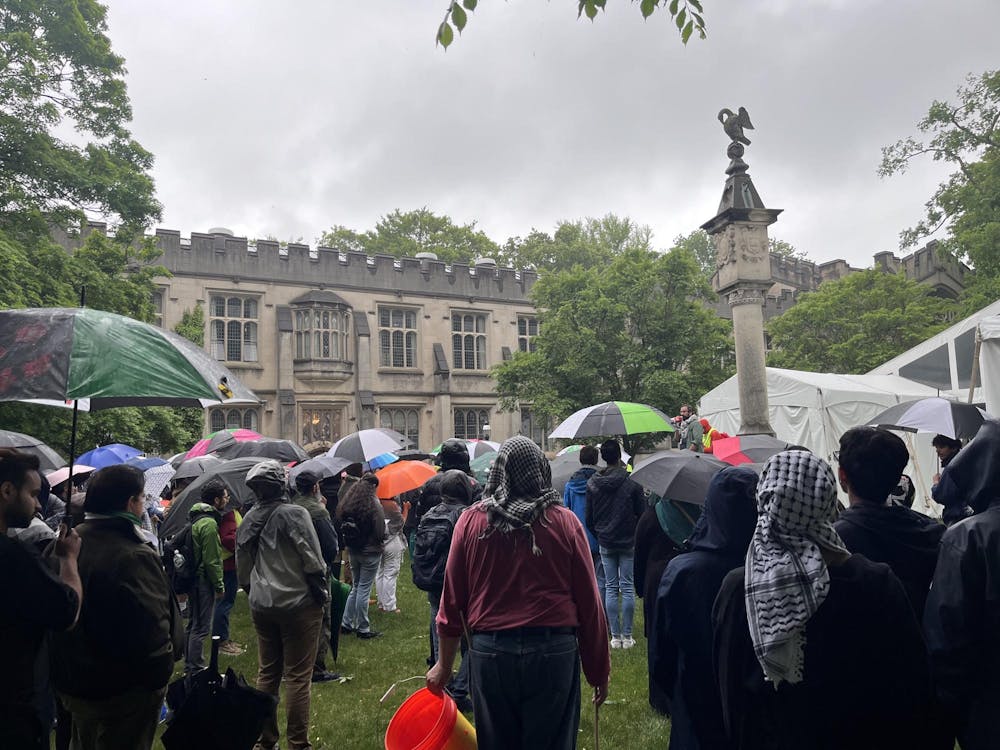The longest sit-in in Princeton’s history evaporated quietly into the rain late on Wednesday night, ending nearly three weeks of rallies, lectures, art installations, and mic checks that thrust Palestine to the forefront of campus consciousness.
University President Christopher Eisgruber ’83 first told protesters to clear the camp on Cannon Green on Monday night, but did not specify a timeline for doing so. After convening with administrators on Tuesday morning, protesters stayed until Wednesday to hold a series of events commemorating the Nakba, the displacement of about 700,000 Palestinians in 1948 during the establishment of the state of Israel.
Protesters began cleaning up around 9 p.m. on Wednesday, rolling up tarps, sorting through food supplies, and taking down banners and signs strewn around Cannon Green. By midnight, the space was largely cleared, and the roughly half a dozen people remaining on the green began singing “Happy Birthday” to the sit-in, to commemorate the three weeks of the encampment.
Over its three weeks, the sit-in functioned as both a protest and as a community space, featuring events from fiery rallies and a week-long hunger strike to Shabbat services and the communal serving of maqluba, a traditional Palestinian rice dish.

Maqluba, a traditional Palestinian rice dish that means "something flipped upside down" in Arabic, is served at the Princeton Gaza Solidarity Encampent on April 28.
Calvin Grover / The Daily Princetonian
“When I think about what I learned from what this movement could look like, I want it to be characterized by the love and the care and the trust and the warmth that I have seen over the past three weeks,” Noura Shoukfeh ’25 said at a rally on Wednesday evening.
But the sustainability of the sit-in was not clear from its beginning on the morning of April 25. Tents in McCosh courtyard lasted for just ten minutes after the Department of Public Safety (PSAFE) made two arrests.
As the first day progressed and students exited their classes in McCosh and Dickinson Halls, the crowd swelled, peaking at approximately 300–400, to listen to lectures from faculty members, including some who held class at the sit-in. That night — in line with the University’s prohibition on sleeping outside — dozens of people stayed awake in shifts in freezing temperatures to hold the space.

But as students shifted from classes to reading period, McCosh courtyard saw far less foot traffic, and view of the sit-in was obstructed from upper campus by the courtyard’s large white Reunions tent. Momentum surged with the brief occupation of Clio Hall and the sit-in’s move to Cannon Green. Demands for amnesty for the 13 students arrested on that day — as well as the two graduate students arrested on the sit-in’s first morning — became a major rallying point for protesters, including the 17 undergraduates who began a hunger strike on May 3.
The Clio Hall occupation also brought the protest under increased scrutiny from the University, which had not issued a statement since the day before the sit-in, when organizers’ planning documents were leaked. The University had preemptively declared that any students who participated in an encampment would be arrested and barred from campus — taking a much more forcible stance than administrators at peer institutions such as Brown and Harvard, who did not commit to the involvement of law enforcement even during the first days of their respective encampments.
Following the events at Clio Hall, the University began engaging more with protesters, first with a series of statements in the following 24 hours. In these, President Christopher Eisgruber ’83 called the occupation “completely unacceptable,” and Vice President for Campus Life W. Rochelle Calhoun wrote that additional people involved at Clio Hall could be subject to criminal charges or University discipline.
Eisgruber then met with members of the sit-in’s bargaining team on May 6 to discuss their demands, a discussion that students largely said was unproductive. Subsequent meetings with administrators had mixed results; the University announced on Monday that the Council of the Princeton University Committee (CPUC) would formally take up divestment but would not consider key demands such as an academic boycott of Israel and complete legal and disciplinary amnesty for arrested students.

The sit-in’s move to Cannon Green provided greater visibility and proximity to buildings like Nassau Hall, where organizers held a rally titled “ALL OUT FOR RAFAH” on Dean‘s Date that drew approximately 350 people, including students and many community members. But the new location also came with new challenges: a larger area to occupy, less tree protection from both sun and rain, and tightened access to surrounding buildings, with both Morrison Hall and Clio Hall closed to students for multiple days. Despite intermittent rain, PSAFE officers began more stringently enforcing regulations on structures at the sit-in, including some tarps meant to shelter hunger strikers who remained outside.

Trash bags were used during the clean-up effort on Wednesday
Miriam Waldvogel / The Daily Princetonian
The force of the sit-in — having already dwindled as undergraduate students buried themselves in reading period and exams — continued to relent over the weekend, with the remaining hunger strikers ending their strike on Sunday (although seven students took their place). In its final days, fewer than a dozen people remained on Cannon Green during the nights, although more congregated during the daytime, particularly around meals.
Cannon Green is now clear, surrounded with orange fences as the University prepares for the debauchery of Reunions, and Class Day and Commencement to follow. But as campus life rolls on, organizers of the sit-in have declared in a statement that their demands will remain the same, and hinted that they will be back.
“See you at Reunions,” they concluded.
Miriam Waldvogel is an associate News editor and the investigations editor for the ‘Prince.’ She is from Stockton, Calif. and often covers campus activism and University accountability.








